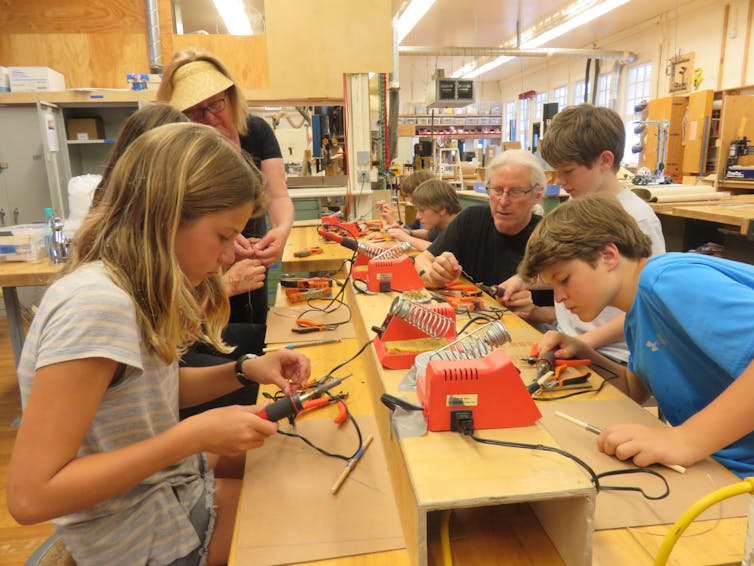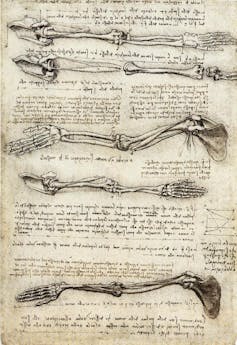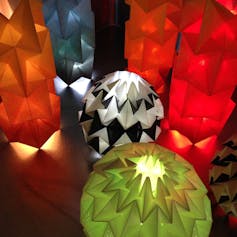Explainer: what's the difference between STEM and STEAM?

Bronwen Wade-Leeuwen, Macquarie University; Jessica Vovers, University of Melbourne, and Melissa Silk, University of Technology Sydney
Gonski 2.0 urges us to get our children back to basics through the “three Rs” of reading, writing and arithmetic. For educators, there is now a greater need for science, technology, engineering and maths (STEM) concepts to integrate with the arts (STEAM) across the wider curriculum.
We know this because business and industry broadcast that future-ready employees need to have multiple areas of expertise or at least appreciate how a range of skills fit together.
Teachers working in cross-curricular STEAM settings often see their students making connections between concepts and solving problems in new and exciting ways. They demonstrate this by active engagement, their discoveries visible in enthusiastic “aha” moments.
What’s the difference?
STEM represents science, technology, engineering and maths. “STEAM” represents STEM plus the arts – humanities, language arts, dance, drama, music, visual arts, design and new media.

The main difference between STEM and STEAM is STEM explicitly focuses on scientific concepts. STEAM investigates the same concepts, but does this through inquiry and problem-based learning methods used in the creative process.
This looks like groups of learners working collaboratively to create a visually appealing product or object that is based in the understanding of a STEM concept, such as the mathematics of the parabola used to create fine art imagery.
STEAM is not a new concept. People such as Leonardo Da Vinci have shown us the importance of combining science and art to make discoveries.
Indigenous Australians also have a long-standing tradition of scientific knowledge passed down through song as a memory system.
Why is STEAM important?
STEAM education in schools provides students with the opportunity to learn creatively, using 21st century skills such as problem solving. Gonski 2.0 and the Australian Curriculum highlight the importance of these skills for a future Australian workplace. These general capabilities are crucial to growing a future-ready workforce that understands the potential of “what if” when solving problems that occur in real life.
They also point us in the direction of 22nd century skills – connection, care, community and culture.
Practical applications of STEAM
Educators and inspiring collaborators like artist/engineer Stephen Mushin, maths rockstar Eddie Woo, scientist Vanessa Pirotta, bio-engineer Melissa Knothe Tate show us how STEM plus the arts works in the real world.
Read more: The hunt for the Superstars of STEM to engage more women in science
A perfect example is artist and designer Leah Heiss. She works with nanotechnolgists in biomedical industries to develop jewellery to assist diabetics administer their insulin.
There are lots of hands-on learning opportunities popping up in schools and institutes all over the country. These are generally called “maker spaces”. They encourage collaboration in learning and discovery, using science and tech resources such as soft circuits, embedded video, game creation, data art, and more.
We are beginning to see this type of learning creeping into everyday curriculum. This is particularly so in the cross-curriculum priorities in the ACARA’s National Curriculum, where the arts context is used to demonstrate STEM concepts and vice versa.
So the idea of “what if?” is not dependent on the purchase of STEAM-specific technologies or even classroom or maker space design. It’s more dependent on the imagination and curiosity of the teachers collaborating with their students.
Read more: STEAM not STEM: Why scientists need arts training
It’s exciting to see so many STEAM concepts embodied in current popular culture, inspiring confidence in young women in particular. Characters like Shuri in the movie Black Panther - the intelligent, creative and playful technologist - help us move beyond historical stereotypes associated with STEM and inspire new generations of interdisciplinary innovators.
How can we forget Daria and Eliza Thornberry, Velma from Scooby Doo and Lisa Simpson? All super smart STEM girls using hard and soft skills to solve a wealth of problems, no different from current Superhero Techgirls and Rosie Revere, Engineer. It’s young people of all backgrounds and abilities who will create our interconnected STEAMy future.
A STEAMy future
STEAM is a global movement. For example, Cambridge University’s STE(A)M education research places professors alongside 12-year-olds. They do live coding to create manipulated music at STEAM education exhibitions.
There’s also the US’ NEXT.cc - a weblog of open source creative STEAM experiences, and OfficeMax in collaboration with Cool Australia, which launched a new national initiative to help educators integrate STEAM learning into Australian primary and secondary schools last month.

Innovative research and resources like these fully realise the intersections between the arts, engineering, mathematics, science and technology, and the influence they have on each other.
![]() With STEAM, we can challenge preconceptions that learning areas are separate, and move past the “I’m good at maths and science, so I’m not creative” way of thinking. This will change the way we see STEM problems and create a new way of thinking that is engaging, multifaceted and inclusive, with diversity of representation and thought. This is how it is in the real world, after all.
With STEAM, we can challenge preconceptions that learning areas are separate, and move past the “I’m good at maths and science, so I’m not creative” way of thinking. This will change the way we see STEM problems and create a new way of thinking that is engaging, multifaceted and inclusive, with diversity of representation and thought. This is how it is in the real world, after all.
Bronwen Wade-Leeuwen, Project Manager, Sustainability Research, Macquarie University; Jessica Vovers, Chemical and Biomolecular Engineering PhD Candidate, University of Melbourne, and Melissa Silk, PhD Candidate, Faculty of Arts and Social Sciences, University of Technology Sydney
This article was originally published on The Conversation. Read the original article.







Please sign in or register for FREE
If you are a registered user on Research Communities by Springer Nature, please sign in